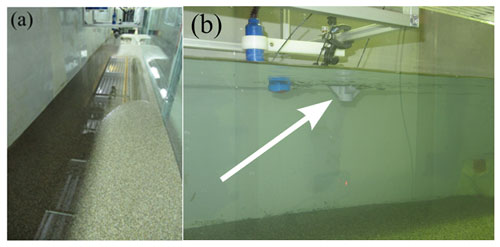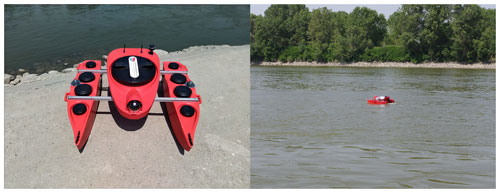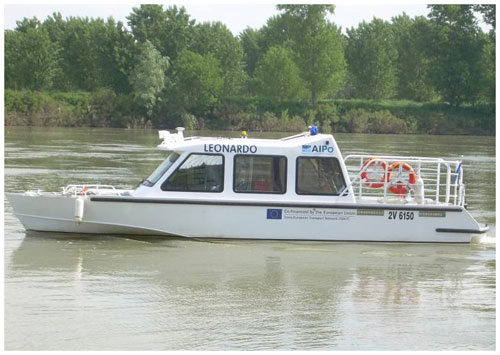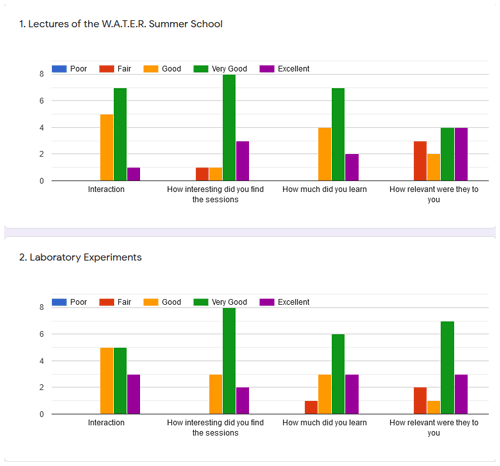the Creative Commons Attribution 4.0 License.
the Creative Commons Attribution 4.0 License.
W.A.T.E.R. – a structured approach for training on advanced measurement and experimental research
Rui Aleixo
Massimo Guerrero
Rui Ferreira
W.A.T.E.R. stands for Workshop on Advanced measurement Techniques and Experimental Research. It is an initiative started in 2016 in association with the Experimental Methods and Instrumentation (EMI) committee of the International Association for Hydro-Environment Engineering and Research (IAHR) aimed at advancing the use of experimental techniques in hydraulics and fluid mechanics research. It provides a structured approach for the learning and training workshop series to postgraduate students (aiming specifically at doctoral students), young researchers, and professionals with an experimental background in fluid mechanics. It offers an opportunity to learn about state-of-the-art instrumentation and measurement techniques and the latest developments in the field by partnering with manufacturers. W.A.T.E.R. brings together academics, instrumentation manufacturers and public sectors in a structured setting to share knowledge and to learn from good practices. It is about training people who already have a certain knowledge and skill level but who need to go deeper and/or wider in the field of measurement and experimental research.
- Article
(3390 KB) - Full-text XML
- BibTeX
- EndNote
There were several motives underpinning the creation of a workshop series dedicated to training of researchers and professionals in the field of instrumentation in hydraulics and fluid mechanics. Among the hydraulics research community, it is identified that there are needs: (i) to provide continuing education and training in advanced and state-of-the-art measurement techniques, (ii) to offer training in experimental research topics that usually are not taught in hydraulics and fluid mechanics curricula, (iii) to strengthen the collaboration with industries developing new experimental techniques and data analysis routines in the field of hydro-environment studies, and (iv) to promote an international environment where researchers coming from different backgrounds can learn and share good practices in measurement techniques and experimental research. Since items (iii) and (iv) fit within the scope of the Experimental Methods and Instrumentation Committee (EMI) (https://www.iahr.org/index/committe/1, last access: 11 May 2022), its leadership team (2015–2017) fully supported the idea of Margaret Chen to organize such a workshop series. The first edition of W.A.T.E.R. took place in 2016, in Oostende, Belgium, organized by the Vrije Universiteit Brussel. Since 2016, five editions have been organized; due to the pandemic the edition of 2020 was postponed to 2021 and took place in Bolzano, Italy. Currently, the 2022 edition is under preparation and will be organized by the Instituto Superior Técnico of the Universidade de Lisboa. Table 1 presents the W.A.T.E.R. workshop series already organized and the upcoming one. W.A.T.E.R. is fully aligned with the strategic plans of both the EMI and of the International Association for Hydro-Environment Engineering and Research (IAHR, https://iahr.org/, last access: 11 May 2022) (https://www.iahr.org/index/committe/1, last access: 11 May 2022). Hence, the current leadership team of the EMI committee has on its agenda to include W.A.T.E.R. as a regular event applying the W.A.T.E.R. standard procedures and guidelines for selection of future host organizations and venues.
It is worth noting that the international scope of W.A.T.E.R. is also reflected in the lecturers, who come from different higher education institutions and research organizations: besides the experts from the Vrije Universiteit Brussel (Belgium), University of Ghent (Belgium), and Royal Belgium Institute of Natural Sciences (Belgium), the renowned researchers are also from the Instituto Superior Técnico (Portugal), École Polytechnique Fédérale de Lausanne (Switzerland), University of Bologna (Italy), and Università de Roma – La Sapienza (Italy), to name a few. A complete list of the lecturers can be found at https://watersummerschool.wordpress.com/lecturers-2/ (last access: 11 May 2022).
The fundamental characteristic of W.A.T.E.R. is its hands-on philosophy. From the start it was decided that the course would have a strong practical component with laboratory and field measurement sessions. In W.A.T.E.R., besides the theory associated with each technique/instrument, the participants are encouraged to practice the different techniques in both laboratory and field conditions. To achieve this goal, different assignments are proposed, allowing the participants to measure real flows with different techniques and to process and analyse the measured data while at the same time working in groups of diverse scientific and cultural backgrounds.
Another characteristic of W.A.T.E.R. is to introduce participants not only to established techniques, such as 2D particle image velocimetry (PIV), but also to present the most recent developments and latest technologies. Different manufacturers, such as ILA5150 (ILA5150, https://www.ila5150.de, last access: 11 May 2022) and UBERTONE (UBERTONE, https://www.ubertone.com, last access: 11 May 2022), partnered with W.A.T.E.R. and presented their cutting-edge know-how to W.A.T.E.R. An example was the introduction by UBERTONE, in the fourth edition of W.A.T.E.R., of its novel instrument (launched in 2019) the Acoustic Doppler Velocity Profiler (ADVP) allowing for the simultaneous measurement of the profile of two velocity components. At the same edition, ILA5150 presented its most recent version of PIV software as well as an illumination set-up based on high-energy LEDs, thus avoiding the use of lasers and making their PIV system more portable.
In addition, since W.A.T.E.R. is being co-organized with universities, it can be recognized for learning credits (e.g., the European Credit Transfer and Accumulation System – ECTS) and thus provides support to its postgraduate participants completing part of their advanced training leading to doctoral degrees. The academic recognition is realized in accordance with the educational and other relevant regulations defined by the respective host university, including the assessment of the study load. Typically the study load is equivalent to three to five ECTS. Three ECTS were granted for the first three editions in Belgium, and five ECTS were granted for the fourth (at Bologna) and fifth (at Bolzano) editions in Italy.
All the teaching materials, including PowerPoint presentations, software, exercises, and references, are prepared in advance and distributed to the participants during each edition of W.A.T.E.R.
Finally, another feature of W.A.T.E.R. is providing advanced training at reasonable costs. The fees are meant to cover the essential material costs of each edition. The W.A.T.E.R. initiative aims to be financially neutral. It is typically a five-day event, and the fees are used to cover the major expenses, including the travel costs of invited lecturers, catering, facilities, insurance, etc. The registration fees of the first two editions included the accommodation costs for the participants. Due to increasing costs of accommodation and diverse preferences from the participants, it was decided to drop this option and to exclude the accommodation costs from the registration fees from the third edition onward. The registration fee from the latest edition (in 2021) was EUR 490.
2.1 W.A.T.E.R. organization
Figure 1 depicts a typical W.A.T.E.R. schedule. The first day and a half is filled with the theoretical part of each technique. Then it follows another day and a half that is dedicated to the parallel laboratory sessions, keynotes, and master classes. Master class is the time allocated to participants who, on a voluntary basis, wish to present their research and receive feedback from the lecturers and other participants. A full day is dedicated to field measurements, and the last day is dedicated to preparing the reporting (morning) and evaluation (afternoon).
Versatility is one of the main features of W.A.T.E.R., and alternative plans are ready in case the original plan has to be modified due to, for example, the impossibility of field measurements because of unforeseen bad weather. Time is also allocated to social events, such as the ice-breaking gathering in the evening of the first day and the W.A.T.E.R. dinner. Furthermore, the interactive coffee breaks and lunches are provided to allow participants to discuss and interact.
2.2 W.A.T.E.R. outreach
W.A.T.E.R. has an official website (W.A.T.E.R. website, https://watersummerschool.wordpress.com/, last access: 11 May 2022) to provide the relevant information about the ongoing activities, deadlines, application procedures, etc. To reach out to its potential members, W.A.T.E.R. also has a presence on Facebook (W.A.T.E.R. Facebook, https://www.facebook.com/WaterSummerSchool, last access: 11 May 2022): this allows easier communication and interaction with potential participants.
In hydraulics and fluid mechanics several measurement techniques exist and are frequently used. At W.A.T.E.R., the emphasis is given to acoustic-based and optical-based techniques. The former deals with velocity measurements based on the acoustic Doppler effect and the latter with velocity measurements based on laser Doppler and imaging techniques such as PIV and particle tracking velocimetry (PTV). This choice stems from the fact that these families of techniques are almost ubiquitous in many laboratories and field monitoring stations.
Acoustic-based instruments allow measuring of the fluid velocity in a point or in a profile along the instrument axis (Muste et al., 2017). It is possible to achieve sampling frequencies of 100 Hz, allowing these instruments to measure turbulent fluctuations. Acoustic instruments are usually sturdy and well built, allowing them to be deployed in the field and work under rough flow conditions and with turbid and poach fluids.
Optical-based techniques, in particular PIV (Raffel et al., 2010; Adrian and Westerweel, 2011), rely on image acquisition and processing. PIV allows measuring of the whole flow in the image plane and thus constitutes a valuable tool for flow measurements. The acquisition frequency of the PIV was set at 50 Hz. Its most common use is in the laboratory, as the need for optical access and delicate optical alignments hinders frequent use in field conditions, although it is possible, under special circumstances, to also deploy it in the field. For field applications PIV algorithms are often applied to surface images to measure the surface velocity using the same algorithms (Jodeau et al., 2017; Lewis and Rhoads, 2018).
Particle tracking velocimetry (Hassan and Canaan, 1991; Capart et al., 2002), from a point of view of image processing, is also presented during W.A.T.E.R. The PTV, with images acquired at 100 Hz, allows the participants to complement the training of PIV with a similar but different technique.
In addition, since 2019, laser Doppler velocimetry (LDV) has also been introduced as an example of a point-wise technique. LDV is often used, over other forms of flow measurement, as a standard for reference and calibration, given that it constitutes the greater accuracy to measure the fluid velocity at a given point in turbulence studies and generic fluid mechanics measurements. The acquisition frequency ranged from 130 Hz for the short times series to 350 Hz for the long time series.
By partnering with two key players in acoustic and optical solutions, UBERTONE and ILA5150, W.A.T.E.R. provides its participants with access to state-of-the-art techniques.
3.1 Experimental set-ups
The experimental part of W.A.T.E.R. is typically carried out in the hydraulics laboratory of the organizing university. This allows the participants to use already existing installations as well as provides examples of didactic and research relevance. Experiments are performed in set-ups that allow the participants to be aware of the potentialities and limitations of each technique. Some set-ups provide classical problems such as the flow around a cylinder (Fig. 2), including the calculation of the Strouhal frequency of vortex shedding and mean drag and lift coefficients. In this set-up PIV is often used, allowing measuring of the planar flow field around the cylinder for different Reynolds numbers. Participants start the respective assignment by setting up the parameters of the PIV, namely the time between consecutive frames, focus of the image, calibration, etc.; then they proceed to acquire flow images, and finally they process the data to obtain the velocity field. By post-processing the measured velocity field, they extract the generated vortices' frequency to calculate the Strouhal number and compare it with the literature. Another set-up is aimed at boundary-layer turbulence (Schlichting and Gersten, 2017), allowing the participants to determine the mean velocity and second-order moments using, for example, an ultrasonic velocity profiler (Fig. 3).

Figure 2PIV measurements of the flow around a cylinder. (a) On the right the flume with a cylinder being lighted by the laser and, on the left, on the monitor, the obtained flow image in real time. (b) The obtained velocity map. PIV system courtesy of ILA5150 (W.A.T.E.R. 2017).

Figure 3(a) Hands-on session measuring velocity profiles in a channel using UBERTONE's UB-Flow. (b) Measured mean velocity profile (W.A.T.E.R. 2017).
It is common to compare two different techniques. For example, at the fourth edition of W.A.T.E.R. in Bologna, the novel ADVP was used to measure a boundary-layer flow at the same section as the LDV, allowing participants to conduct a direct comparison and to discuss advantages and disadvantages of each technique (Fig. 4).

Figure 4Hands-on session during W.A.T.E.R. 2019 in the Hydraulics Laboratory of the University of Bologna (Italy): (a, b) two-component velocity profile measurements with ADCP provided by UBERTONE.
During the experimental courses, the lecturers are present and guide each session on the technique they lectured, allowing a better coupling between theory and practice. The discussion is further enhanced by the presence of personnel from the industries that provided the instruments.
To optimize the time and laboratory spaces, different set-ups run in parallel: this allows the maximized experience of each participant to have hands-on training of each technique lectured on the W.A.T.E.R. programme.
3.2 Field measurements
Field measurements are also part of the curriculum of W.A.T.E.R. Field measurements in Oostende include measurements in the North Sea in research vessel Simon Stevin of the Flemish Marine Institute (https://www.vliz.be/en/rv-simon-stevin, last access: 11 May 2022) (Fig. 5). Field measurements in Bologna were made possible thanks to the Po River Agency (https://www.agenziapo.it/content/english-presentation, last access: 11 May 2022) (Fig. 6). Field measurements allow participants to be in contact with different users of experimental techniques, specifically state agencies. It allows them to understand the limitations and challenges of field measurements and to get in touch with novel approaches, such as the use of unmanned vehicles (Fig. 7).

Figure 5Research vessel Simon Stevin, courtesy of the Flemish Institute of the Sea (W.A.T.E.R. 2016 and W.A.T.E.R. 2017).

Figure 7Proambiente's unmanned survey vehicle, during the field measurement session at the Po River during W.A.T.E.R. 2019.
By partnering with local public organizations, W.A.T.E.R. provides access to state-of-the-art research facilities and instruments such as the unmanned survey vehicles (USVs) and Proambiente's USV (Fig. 7).
The participants are evaluated at the end of each W.A.T.E.R. workshop series before issuing the respective certificate with the ECTS. Evaluation is made up of three parts: (i) questionnaire about the different techniques; (ii) oral presentation of the assignments; and (iii) a question session (Q&A) after the presentation. Although participants can prepare their assignment presentation during W.A.T.E.R., the morning of the last day is reserved for report preparation. Debate between lecturers and participants is encouraged during this period, allowing the participants to clarify relevant questions.

Figure 9The distribution of the W.A.T.E.R. participants regarding the locations of their affiliations (cumulative results).
In order to improve from edition to edition, at the end of each edition, an evaluation form is distributed to the participants, who can anonymously express their critiques and remarks about W.A.T.E.R. Figure 8 depicts the results of the evaluation made by the participants of the latest edition in 2021.
The profile of the typical W.A.T.E.R. participant has a mean age of 29 years old, with most of them pursuing doctoral degrees. However, about 25 % of the participants are professionals who need to upgrade or improve their competencies in the experimental hydraulics and measurement techniques domain. Among the participants about 65 % are male and 35 % are female; 75 % of the participants come from Europe, 13 % from Asia, 8 % from South America, and 4 % from North America. Figure 9 depicts the cumulative results of where the participants and lecturers come from. Here the locations of affiliation and not nationality are considered. For instance, an attendee from India pursuing his/her doctoral study in Belgium is counted as a Belgian participant.
W.A.T.E.R. is a training workshop series designed to offer training in advanced measurement techniques in hydraulics and fluid mechanics. The organization of the workshop series is done in cooperation between universities and instrument manufacturers, and the advantages are twofold: (i) the recognition of the training in terms of ECTS; (ii) the access to state-of-the-art techniques. Furthermore, it provides a welcoming and friendly environment where participants from different backgrounds can interact and improve their skills. Social events are also part of the programme, providing time to network and relax.
The light organization of W.A.T.E.R. and a programme that has been tested and improved for five consecutive editions allow it to easily adapt to different scenarios and circumstances and to provide meaningful and useful contents to the participants. The current leadership team of the EMI committee is determined to support W.A.T.E.R. as a structuring event of the committee and as a regular occurrence on the IAHR agenda.
All data and related information are publicly accessible via https://watersummerschool.wordpress.com/ (last access: 11 May 2022; W.A.T.E.R., 2022).
Conceptualization of W.A.T.E.R. was by Margaret Chen and Rui Aleixo. The original draft preparation was by Margaret Chen and Rui Aleixo. All the authors participated in the revision and finalization of the manuscript.
The contact author has declared that neither they nor their co-authors have any competing interests.
Publisher’s note: Copernicus Publications remains neutral with regard to jurisdictional claims in published maps and institutional affiliations.
This article is part of the special issue “Education and professional development in hydro-environmental engineering”. It is a result of the 6th IAHR Europe Congress 2020, Warsaw, Poland, 30 June–2 July 2020.
Thanks to Marie Burckbuchker and Stephan Fischer from UBERTONE and Frank Michaux from ILA5150 for the technical support given to W.A.T.E.R.
This paper was edited by Michael Nones and reviewed by David Ferras and one anonymous referee.
Adrian, R. J. and Westerweel, J.: Particle Image Velocimetry, Cambridge University Press, ISBN 978-0-521-44008-0, 2011.
Capart, H., Young, D. L., and Zech, Y.: Voronoï imaging methods for the measurement of granular flows, Exp. Fluids, 32, 121–135, https://doi.org/10.1007/s003480200013, 2002.
Hassan, Y. A. and Canaan, R. E.: Full-field bubbly flow velocity measurements using a multiframe particle tracking technique, Exp. Fluids, 12, 49–60, 1991.
Jodeau, M., Hauet, A., Le Coz, J., Bercovitz, Y., and Lebert, F.: Laboratory and Field LSPIV Measurements of Flow Velocities Using Fudaa-LSPIV, a Free User-Friendly Software, Proceedings of the HydroSensoft Conference, HydroSenSoft, International Symposium and Exhibition on Hydro-Environment Sensors and Software, Madrid, Spain, 1–3 March 2017, https://iahr.org/library/infor?pid=19562 (last access: 11 May 2022), 2017.
Lewis, Q. W. and Rhoads, B. L.: LSPIV Measurements of Two-Dimensional Flow Structure in Streams Using Small Unmanned Aerial Systems: 1. Accuracy Assessment Based on Comparison With Stationary Camera Platforms and In-Stream Velocity Measurements, Water Resour. Res., 54, 8000–8018, https://doi.org/10.1029/2018WR022550, 2018.
Muste, M., Lyn, D. A., Admiraal, D. M., Ettema, R., Nikora, V., and Garcia, M. H. (Eds.): Experimental Hydraulics: Methods, Instrumentation, Data Processing and Management, 1st edn., CRC Press, ISBN: 9781315158839, 2017.
Raffel, M., Willert, C. E., Wereley, S. T., and Kompenhans, J.: Particle Image Velocimetry – A Practical Guide, 2nd edn., Springer, ISBN: 978-3-540-72307-3, 2010.
Schlichting, H. and Gersten, K.: Boundary-Layer Theory, Springer, Berlin, Heidelberg, https://doi.org/10.1007/978-3-662-52919-5, 2017.
W.A.T.E.R.: W.A.T.E.R. Workshop on Advanced measurement Techniques and Experimental Research, W.A.T.E.R. Summer School – Lisbon, 18–22 July 2022, https://watersummerschool.wordpress.com/, last access: 11 May 2022.









